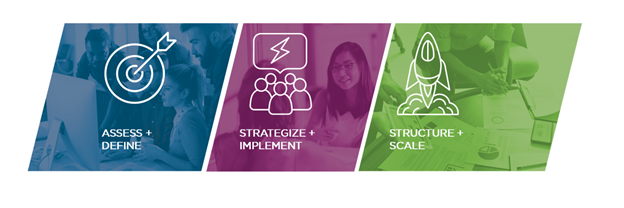
Many analytics leaders will agree that talent is the most valuable asset in their organization— and the most challenging. But how much time do analytics leaders really spend designing the team they will need five years from now? For many, it is difficult to carve out the time and to know how to develop a strategic workforce plan. Part of the challenge is focusing beyond this year. With current gaps in the team, more work than people to do it, and pressure to show the value of current deliverables, there is no time or energy to think beyond the immediate future. However, the leader that takes that time to create a workforce strategy beyond the next 12 months when it comes to their analytics team can end up ahead, with a stronger team, fewer talent shortages, and more deliverables accomplished.
Developing A Strategic Workforce Plan
So how do you develop a workforce plan that is strategic in nature? Start by identifying the organization’s strategic plan, the analytics strategy, and multi-year projects for 2-5 years from now. Once the current project plan has been accomplished (12-24 months from now), review what projects may start in the next 1-2 years.
- What needs are currently backlogged? What is waiting for leadership support?
- What will be next in the evolution as the demand for advanced analytics work surpasses the amount of work that can be done with the existing team?
- What is next on the analytics maturity journey?
It sounds so simple, yet it is not. It is not clear what projects will get approved in the next round or what the strategic focus for the business will be in 2-3 years. However, if the analytics leader can at least get a spectrum of what is likely to occur, themes can be identified. For example, regardless of which specific projects get approved (Project 1, 2, or 3), all of those projects will likely require a certain set of similar skills that will need to be developed in the analytics team. The business leaders are looking to the analytics leaders to identify how to move to that next step in the analytics maturity life cycle and anticipate what skills and roles will be needed in the future as the importance of data and analytics continues to grow. Often, the best ideas come from the best talent. So, what if there was a clear plan for how to develop and hire the top-notch talent and change the capabilities of the team for the future?
Once the range of potential future projects has been identified, the analytics leadership team, along with human resources, can work together to identify the skills and capabilities that are needed to accomplish that work. More than likely, a need will be identified for an increase in skill sets with advanced analytical techniques, big data, additional specialization, an increase in business acumen, and stronger communication/presentation skills. There may also be a need for an increase in specific roles (more data engineers, fewer entry-level data scientists) within the analytics teams while increases in other roles may not be warranted . Instead of focusing on specific numbers, the analytics leadership team should focus on directional shifts (+/-/=) and percentage changes to get some idea of the magnitude of change that will be needed in the future.
That conversation about the number of employees, contractors, and other resources that will be needed in order to accomplish the job is also critical. Not all talent resources are internal/employees. Again, thinking of it in percentages can be helpful.
- What is the percentage of contractors and vendors as it compares to the total analytics workforce today?
- What ratio of internal vs. external talent is desired for the future?
- How will it be determined that too many outside sources or being utilized vs. developing that skillset in-house?
Answering these and other directional questions starts to formulate a plan for what the future analytics team will look like.
An Example of a Multi-Year Workforce Plan
Strategic workforce planning is about being strategic, not about being exactly right. It's about developing scenarios and directional plans that will lead towards the future. No one knows what the future will hold, but that uncertainty doesn't mean that a baseline of what will likely be needed can't be established. For example, if one of the talent pipeline strategies is bringing in analytics interns and then hiring new college graduates to fill entry-level data scientist positions, then a minimum of a two -year preparation period is needed.
Year 1: Recruit and hire the analytics interns.
Year 2: Hire new college graduates who begin full-time work and go through the onboarding process.
It's not until the end of year two that those original interns are fully able to contribute to the team. So, how much work and effort is being put into forecasting the number of interns and the skills that should be developed in the next intern class? Analytics leaders must think about completing projects that need to be done this year, but also identify and train the workforce for future work that will be needed two years from now.
- What building blocks and exposure do the interns need for the future?
- How many new analytics roles will be needed across the organization 3-5 years from now that drives the current scope of intern roles (i.e., four data scientists, three data engineers, two visualization specialists)?
SWP Framework
A framework can be helpful when thinking about long-term future talent needs. Here are three steps to follow when developing a strategic workforce plan:
- Assess and Define the current and future workforce needs.
- Strategize what takes priority and Implement the workforce plan over the next 1-3 years.
- Evaluate the organization Structure and determine steps to Scale to the next level of analytics maturity.

1. Assess & Define
This step is a combination of assessing the future supply and demand of the workforce. First, Identify the demand in the workforce that will be needed to accomplish those strategic objectives:
- What will be needed to backfill forecasted attrition?
- What additional workforce will be needed?
- What roles and in what approximate quantities (across the organization or just for the COE)?
Then, analyze the supply of analytics talent in the workforce:
- Where is talent that will be needed for the organization based on the current maturity and development?
- What partnerships can be developed now to strengthen the talent pipeline?
- What are the attrition goals and what pipelines best meet those goals?
2. Strategize & Implement
Once the need has been identified, analytics leaders must develop and prioritize multiple workforce strategies . Most organizations already have recruiting strategies, development strategies, and engagement strategies in place. Strategic workforce planning is about being strategic about which of those strategies are priorities for the future. Which ones must be in place to drive the rest? What happens if there is a misstep in one of those areas?
For example, at the beginning stages of developing an analytics team, strong leaders are often chosen with vision, change management capabilities, and technical aptitude. As the organization grows, there becomes a need for more technical workers as the demand increases. However, with more employees comes a need for more leaders. If the strategic plan only focuses on building up the technical workforce but doesn't address the leadership talent pipeline, there will be attrition issues in four years as the sharp talent that got hired becomes frustrated due to the lack of strong leadership on the analytics team.
3. Structure & Scale
As the organization continues to scale, several reorganizations may be needed. It is very rare that the structure that meets the needs early in the development of the team also meets the needs as the organization grows and changes. What is the desired structure as the organization and demands shift? How do the analytics leaders work together regardless of the reporting structure?
Eventually, the organization focuses on scaling analytics practices across the various work groups. The same need occurs within the workforce in coordinating recruiting and development efforts across the organization.
- What do career paths look like for analytics talent across all analytics teams?
- What types of analytics community and best practice sharing exist?
- How does skill development happen across the analytics organizations?
The time invested in putting together an overall, directional plan for how the analytic talent will shift in the future is well worth it. The shift will happen, whether you are intentional with it or not. The alternative to not planning for it is to focus only on solving the problems of today and letting the future be dictated by today's issues.
Get started today by thinking about that future workforce and developing some guideposts for how you want to build that future analytics team. With effective planning, you will see the analytics talent become an even larger strategic advantage for the organization.